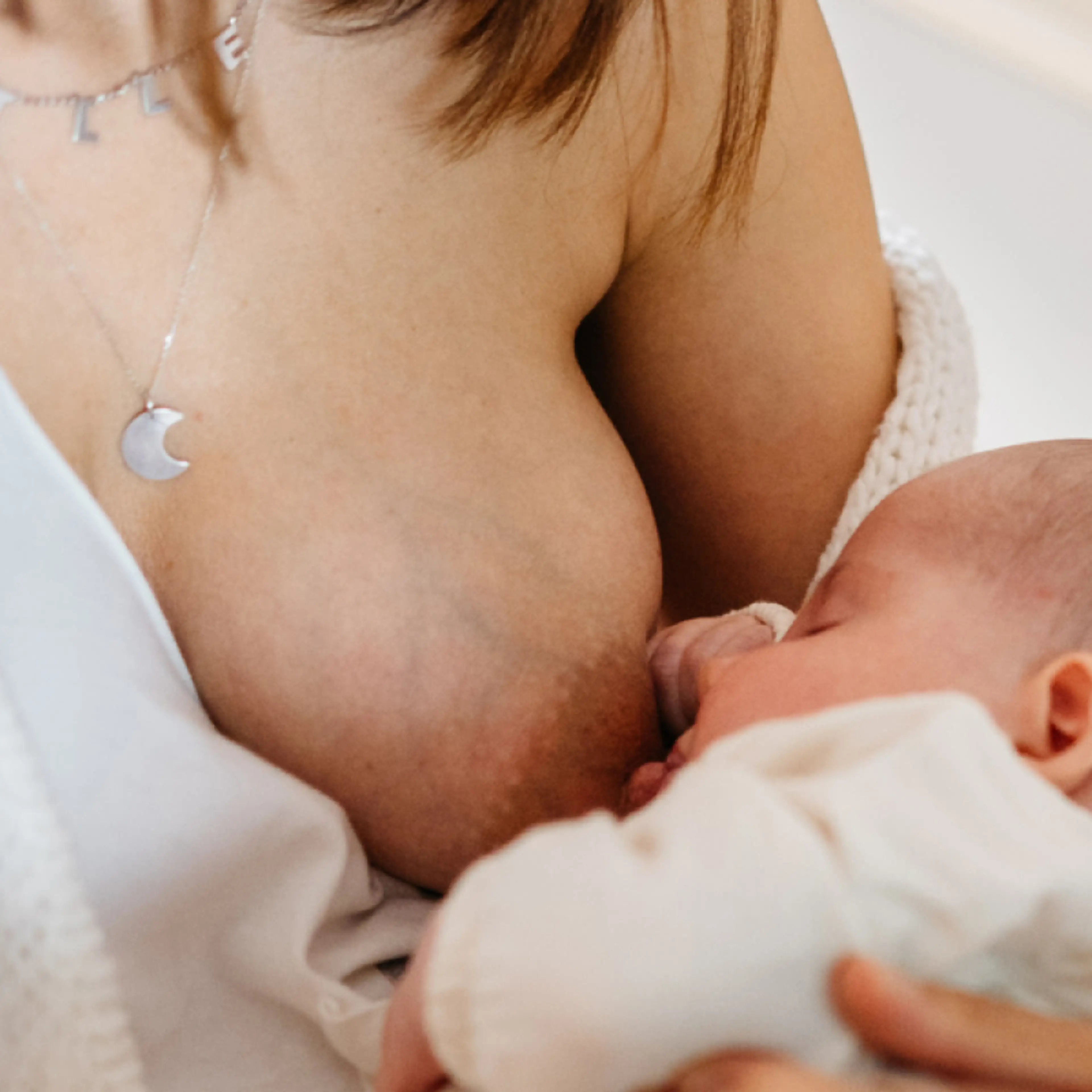TLDR: If you’re breastfeeding, you also may be thinking about pumping so you can have extra on hand, to cover you when you leave the house, or to donate. You also may be exclusively pumping. If you’re new to all this, you probably have questions about when to start pumping and how to store breast milk properly. Find it all here in our breast pumping primer.
If you’re breastfeeding, you may be looking at your brand-new breast pump, wondering, ‘When should I start pumping? The answer to this question is different for everyone.
Some women decide to pump soon after birth, while others may rarely use a pump, if ever.
Understanding the reasons for pumping and the benefits may help decide when is the right time to start for you. Knowing when and how to pump can also help you work through any uncertainty around pumping.
To help put your mind at ease, here’s a guide for new moms on everything you need to know about when and how to start pumping.
Reasons to Start Pumping
There is no one right reason to start pumping. Like most experiences in motherhood, pumping looks different for everyone. Some people may start pumping to increase their milk supply, while others may pump because they want or need to have someone else feed their baby breast milk, either when they’re away from the baby, they need a break (like at night), or for bonding reasons.
If you’re thinking about getting a pump, know that you can order a free or discounted breast pump through insurance.
Here are a few reasons why women may decide to begin pumping.
To encourage milk supply
If you’re one of the many women who have trouble producing enough milk, one way to increase your supply is by pumping, since the amount of milk your breast produces is based on supply and demand.
Lactation consultant Angie Whatley1 says the pump can be a great tool to, well, pump up your supply. “I teach new moms that in the early weeks through the first month your body is making what your baby is demanding, so the more you stimulate your breasts the more milk you make!”
Over time, your body will learn your baby’s needs and continue making enough milk for the demand. Pumping tells your body there’s more demand; it’s been shown that pumping after breastfeeding to remove any residual milk can increase milk volume by 15 to 40%2 .
You’re unable to breastfeed from birth
Some mothers are unable to breastfeed immediately after birth. This may be due to the baby being premature or having special medical needs. If you find yourself unable to breastfeed at birth, but hope to later, it’s important to start pumping early. Research has shown that mothers who pump within an hour of giving birth produce more milk3 at three weeks postpartum. This also can be helpful if you want to feed your baby breastmilk and will be exclusively pumping.
Returning to work or need someone else to feed baby
Many parents leave their babies with a family member, babysitter, or at daycare at some point. If you plan on leaving your baby at all—for a few hours or when you’re going back to work—it’s helpful to have a supply of milk on hand.
When Should I Start Pumping?
If you’re experiencing supply issues or are unable to nurse at birth, but want to be able to breastfeed later, then try to start pumping as soon as possible. The sooner you start pumping, the better your chances of establishing a solid supply of breast milk.
If your main goal for pumping is to have milk on hand for times when you’re not with your baby, you can wait a few weeks to let your milk supply establish itself. If you pump too early, your breasts may begin to overproduce milk. Three to four weeks postpartum is generally regarded as an appropriate time to start pumping.
What Are the Benefits of Pumping?
There are a variety of reasons pumping may be helpful.
To build a stockpile of milk
Having a stockpile of milk can bring you peace of mind, whether you’re away from your baby regularly during the day or just every now and then. If there’s an emergency or unforeseen situation, it’s comforting to know there is breast milk in the freezer for them.
@expectful It's not about the ounces you pump, but the love in every drop 🤍 #pumping #makingmilk #liquidgold #pumpingmama #expectful ♬ original sound - expectful
For supplemental feedings
Your milk supply can dip from time to time. This can occur during different periods in your menstrual cycle, times of high stress, or when you’re taking certain medications. Whatley also notes that your supply can dip if you’re dehydrated. Pumping allows you to have a supply of milk on hand to offer your baby if they need a little more milk between feedings.
To get baby comfortable taking a bottle
Many breastfed babies will need to eat from a bottle at some point. Help them get used to the bottle before they need it. If you’re not experiencing any supply issues, try introducing a bottle to your baby once your milk supply is established. Anytime after the four-week mark is generally recommended.
Donating breast milk
Another benefit to pumping is to donate your breast milk to milk banks. These milk banks will take donated milk, pasteurize it, and provide it to hospitals for preterm babies and babies with medical needs. Some women pump excess milk and donate it to a family or friend who isn’t able to breastfeed.
When Is the Best Time to Pump?
While you can pump at any time during the day, mornings usually are the best time to fit in a pumping session. Your breasts tend to be the fullest first thing in the morning, especially if your baby is sleeping longer stretches at night. You can pump first thing in the morning before your baby wakes up.
You can also pump throughout the day. Try to pump about an hour before your baby needs to breastfeed, or an hour after. Another option is to pump on one breast while the baby is feeding on the other breast. The letdown reflex—when milk is ready to flow—usually happens to both breasts at the same time. Pumping when your baby is feeding may help the milk flow easier.
Whatley also suggests using a manual pump like a Haakaa to catch milk from the breast the baby isn’t feeding on. “It works similarly to single pumping while mom is breastfeeding, but it’s easier to use than getting the pump set up,” she says. “You can potentially collect 1-3 ounces of expressed milk.”
Try different times to find out when pumping works best for you.
How Often Should You Pump?
When it comes to pumping, it’s all about your individual needs. If you‘re pumping to build up your supply to go back to work, you will likely need to pump more than someone who is pumping to have a small stockpile of milk in the event they leave the house without their baby.
If you’re going back to work, you may want to pump on the same schedule your baby would usually feed to keep up your supply. This is usually every three hours.
Whatley notes that it’s important to pump around this interval (whether you’re at work or somewhere else away from your baby) to protect your milk supply. “Milk supply may decline if you are skipping feeding times or not emptying the breast frequently,” she says. “This could be critical for moms already struggling to get a good supply.”
Your breasts will usually give you a sign they are ready to release milk. They may get more firm, or you may feel the letdown sensation.
Is the Amount of Milk You Can Pump a Good Indicator of Milk Supply?
Don’t be discouraged if you’re not pumping as much milk as you were hoping to. You may need to tweak the settings on your pump or try other tricks to help get more milk while pumping (like looking at pictures of your baby while you pump). A qualified lactation consultant can help give you tips on how to have more efficient pumping sessions, as well as help you troubleshoot.
How to Use a Breast Pump
If you’re new to pumping, all the machinery can look a little daunting. How do you know where to put everything with all of their tubes and parts? The best thing you can do before you get started is read the directions of your particular pump. The next thing you will want to do is wash all of the parts that come in contact with your body or breast milk. Washing your pump after every use is also extremely important. Keep your hands and pump as clean as possible to avoid contaminating your milk.
Get comfortable
Before you even turn your breast pump on, get comfortable. Sit in a supportive chair, perhaps listen to a meditation or music you like, and relax. Pumping can feel awkward, especially in the beginning. Getting comfortable and relaxed can help your milk flow4 more easily.
Encourage the let-down reflex
Once you are comfortable, you may need to encourage your let-down reflex5 to make milk flow. The let-down reflex is caused by oxytocin. Oxytocin is made more quickly than prolactin, the hormone that stimulates milk production.
When oxytocin is produced, your body releases the milk already in your breast. This gives your baby—or pump—milk more quickly, while more milk is being produced.
You can also stimulate the let-down reflex easily—watching a video of your baby or even thinking about them may trigger the letdown reflex.
Use the correct flange size
When you purchase your breast pump, it will have a standard-size breast flange—this is the part of the pump that your breast fits into. The standard size just means it fits most women, but certainly not all. You may need to purchase a smaller or larger breast flange from your breast pump maker.
To determine what size breast flange you need, measure your nipple diameter (the length straight across the middle). Once you have that measurement, look at the company’s breast flange sizing to determine which one will best suit your needs.
Pro tip: Take this measurement after your baby is born. Your nipple size can change during pregnancy and breastfeeding, so it’s best to measure them closer to when you need to use your pump.
Use the let-down function on your pump
Many breast pumps have a letdown function. This function will pump at a much quicker pace than the expression function. Just as your baby will change their sucking frequency during let-down and expression, the pump will as well. Change the pump function from let-down to expression once you notice your milk flowing from your breasts. The expression function will have a slower rhythm to the suction.
Use the appropriate suction
When it comes to suction, more is not always better. Try to find the suction level that most closely resembles your baby’s. If the suction is too high, it can inhibit milk flow by squeezing the breast too much. Remember: using a breast pump shouldn’t be painful, so if it is, something probably needs to be adjusted. A lactation consultant can help you.
How to You Store Your Breast Milk
Once you finish pumping, it’s important to store your breast milk correctly. Properly storing your breast milk6 reduces the chances of the milk getting contaminated or spoiling.
On the counter (less than 77°F): Breast milk can sit out on the countertop for up to four hours directly after pumping. If it has been frozen and then thawed, it can sit on the counter for up to two hours.
In the refrigerator (40℉): If you plan to use the expressed breastmilk within four days, it can be refrigerated. If the breast milk has been frozen and thawed, it can stay in the refrigerator for one day.
In the freezer (0°F or colder): Breast milk can be stored in the freezer for up to 12 months, but up to six months is best. Once breast milk is thawed, it should never be put back in the freezer.
Leftover from a feeding: If your baby didn’t finish their bottle of breast milk, it should be used within two hours.
Remember: It’s a Personal Decision
The decision to start pumping is personal for each mother. Depending on your needs, you may decide to pump soon after birth or wait a few weeks until your milk has been established.
Once you decide when or if to start pumping, find a schedule that works for you and your needs. Pumping first thing in the morning, when your breasts are fullest, may be a good time to pump, or you can try pumping between feedings.
You may need to pump more often if you are trying to build a larger milk stockpile. Once you have all of that hard-earned breast milk, make sure you are storing it properly.
Make sure to set yourself up for pumping success: Get comfortable, encourage let-down, and make sure your pump fits your breasts properly.
Read Next: A Guide to Your Boobs from Pregnancy Through Postpartum










